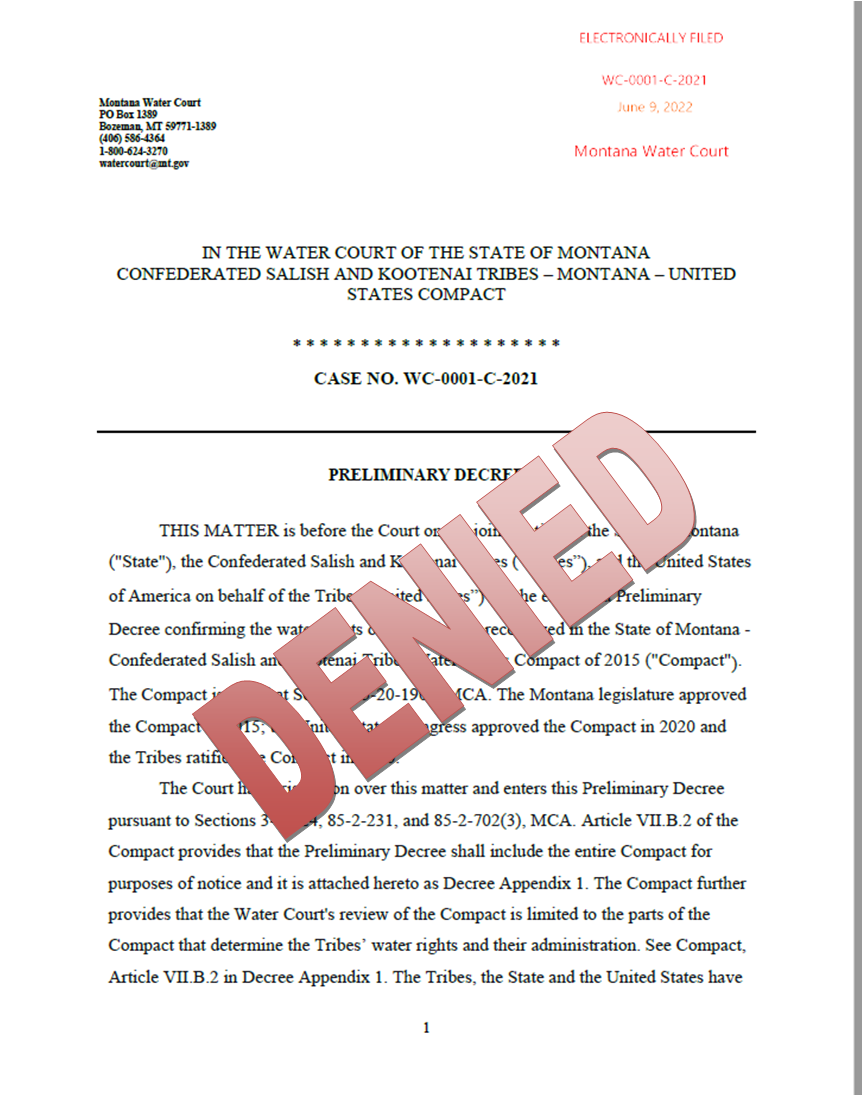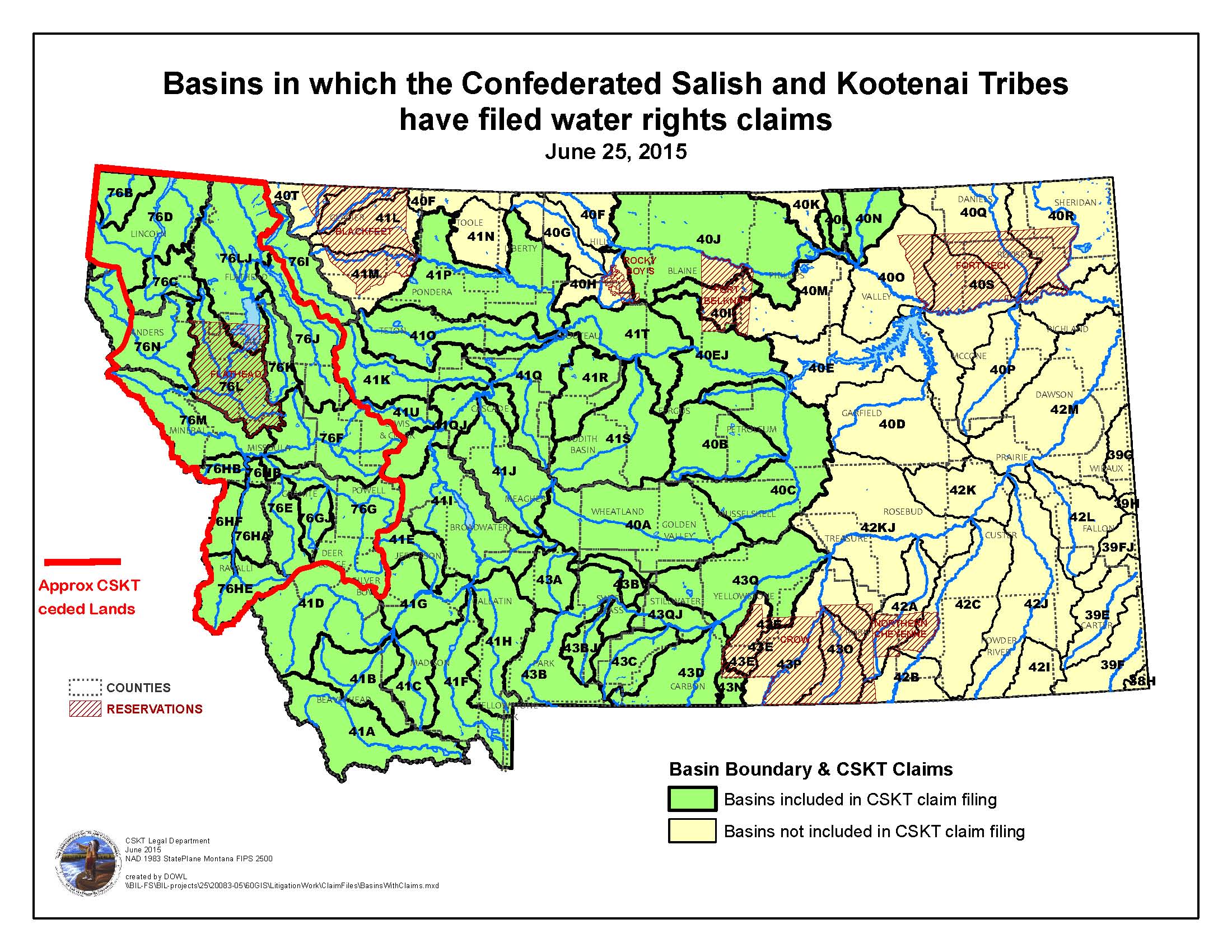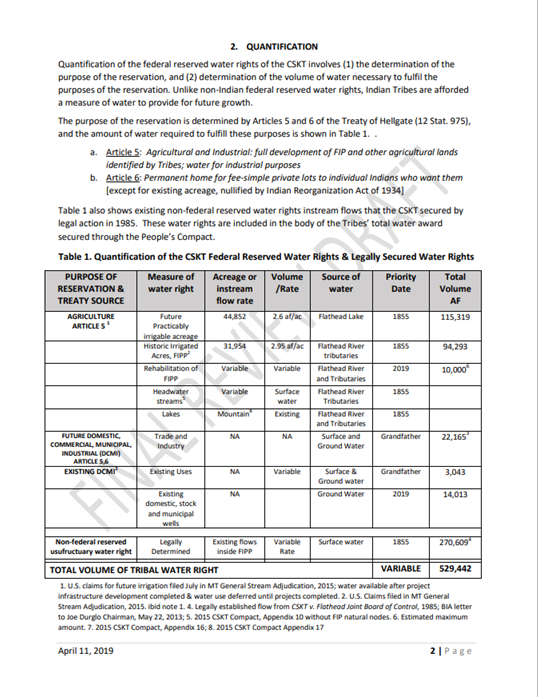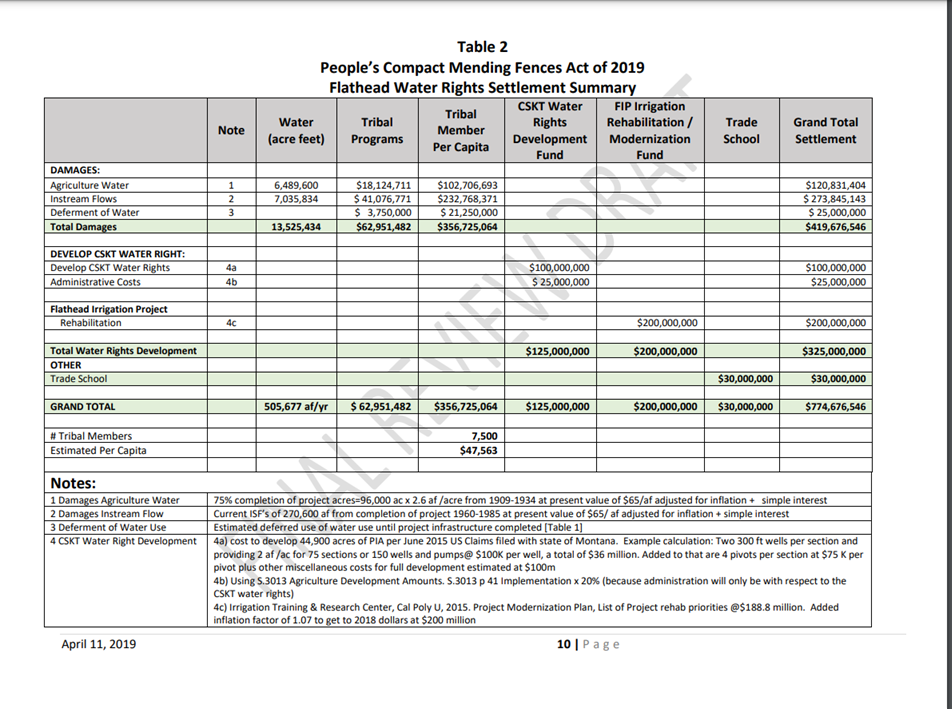© 2023 Concerned Citizens of Western Montana
Note: This article is being written in memory of our dear friend Bob, a fellow water warrior who was with us every step of the way, until he left us far too soon. Not a day goes by that he isn’t in our thoughts.
We’ve talked quite a bit about the fact that the parties to the Flathead Water Compact act as though its approval is a foregone conclusion in the Montana Water Court. While it’s possible that those skids were greased long ago, we prefer to stay positive by knowing in our hearts that we are fighting the good fight against our government hydras.
No matter how slim, there is always a chance for intervention, and the possibility that the Water Court, or perhaps even the United States Supreme Court could give the Compact a thumbs down.
We think the time has come to ask how the Water Compact void would be filled if the Water Court gives it a thumbs down?
This question is absolutely necessary because if given another opportunity, it is highly likely that the compacting parties would attempt to fill the void with something far worse, like the 10,000 claims.
See: Have the Tribe’s 10,000 Claims Come Home to Roost?
First Some History
In 2011, we began a journey to learn about the Flathead Water Compact, an issue that had been looming in the background for decades. We were told by some that it was too controversial, and that we should not publicly focus on it, but what we learned about it were things that could not in good conscience be swept under the rug.
With what little information we learned about it, by early 2012 a small group of people were engaged, and in an effort to learn more about it, we attended our first Compact Commission meeting in Pablo.
During the public comment period, we requested that representatives of the United States, Montana, and the CSKT join us at a town hall meeting at the Ronan Community Center to explain the water compact to the public.
We were sitting in the front row of the public seating area facing all the grandeur of the tribal council chambers. I vividly remember tribal elder Pat Pierre walking up and very boldly accusing us of declaring war on the Indians. In an effort to intimidate further, and in showmanship fashion he then said:
“I’m gonna take a hardcore approach on this thing, cause I think it needs to be that way. Sometimes we get kinda mellowed down and want to be nice to each other, we’re still sitting here smiling across the table. I’m going to take a hardcore approach to this thing. I personally stand here and claim all the water in my aboriginal territory as my water. I will not nod my head until everything goes my way. Should I say it again? I will not nod my head to anything that goes on here until it goes my way.“
His response really was overkill. We had simply asked the parties to explain the compact at a public townhall meeting that would be held in the evening hours so that working people could actually attend.
At the time, we truly wanted to learn more about the compact, but Mr. Pierre must have felt at some level that we were going to resist the compact. And to his credit, that is exactly what we ended up doing.
Because the introduction of the compact to the Montana legislature was a few short months away, we held the townhall meeting in June of 2012. Chris Tweeten, chairman of the Montana Reserved Water Rights Compact Commission was the only representative of the compacting parties that attended the meeting.
Our main takeaway was Tweeten telling everyone that if the compact was not ratified, everyone would have to hire an attorney to defend their water rights. We knew at the time we were late to the game, but this revealed to us that the state’s strategy was to use fear tactics as a means to achieve their compact ratification.
Note: Here we are in 2023, and many people have currently hired an attorney to beat back an overreaching compact that has absolutely nothing to do with “federal reserved water rights.”
2012-2015
From that time forward, we diligently attended every meeting we could, and dug deeply into the history of the compact, as well as the Flathead Indian Reservation.
We started this blog to document the timeline of events related to the compact, and to provide historical documents to help people with their own research (see our LIBRARY page on the top of the blog page).
We looked at every water rights abstract in the compact and developed information and materials and took this information to legislators for their consideration.
Sadly, the Flathead Compact issue was already politicized and we often found that legislators avoided us in Helena.
What is that saying: Hear no evil, see no evil, speak no evil? It was abundantly clear that legislators didn’t want to know the details of the compact. By intentionally not delving into the compact details, we believe they were trying to give themselves something called plausible deniability. Indeed on the House floor when asked how many legislators had read the compact, only a few raised their hands.
Despite all that, we did manage to meet weekly with a handful of legislators to get them up to speed and to discuss current events related to the compact.
Early on, one of the legislators suggested that we should not just oppose the compact, but instead should offer an alternative to it.
In August 2013, we introduced A Proposed Alternative Compact. Our offering was a federal reserved water rights quantification of the tribes water rights, following the legal parameters of what is called the Winter’s Doctrine.
While that effort did get a response from the tribe, and a few mentions in the media, our alternative compact was not fully developed, and essentially went nowhere.
In April 2015, the Montana legislature unconstitutionally and questionably ratified the compact by changing house rules in order to achieve a simple majority vote.
In June 2015, the United States and CSKT filed 10,000 claims covering 2/3 of the state of Montana.
Provisions written into ARTICLE VII FINALITY of the compact legislation provide that those claims and others will be dismissed without prejudice, virtually ensuring there would be no finality to this issue for the people of Montana.
Was Montana just plain negligent, or were they complicit by allowing this language to be added to a compact that they promised the public would be a final settlement of the tribe’s water rights?
2018-2019 The People’s Compact
Several years later, we were approached by a neighbor with the same idea, and in 2018 we introduced a fully developed alternative to the Flathead Water Compact, named the People’s Compact.
See: The People’s Compact Website Both Sides of the Divide
Novices that we were, we worked diligently to develop a Flathead Water Solutions Handbook (submitted to Senator Daines), and a framework for legislation. We even went as far as to write the federal legislation for it.
By 2018 we were far more familiar with the history of the Flathead Reservation as well as the Indian Claims Commission and U.S. Court of Claims settlements with the tribe. We knew what tribal grievances had been settled, what was rejected by the courts and what remained unresolved.
We opened The People’s Compact Website, and our informational newsletter Both Sides of the Divide was inserted into many thousands of newspapers around the state.
Built upon a century of federal reserved water rights law, the People’s Compact fairly quantified the tribe’s water rights and also respectfully considered the present and future needs of individual tribal members.
As per the Winters Doctrine, the People’s Compact included no off reservation water rights, had 1855 priority dates, and provided a quantification for 529,000 acre feet of water, half of which was a non-federal reserved water right for the usufructuary use of interim instream flow claims for fish.
Instead of giving $1.9 or $2.3 billion as a settlement to the tribal government, the People’s Compact proposed that 1/2 of a $775 million dollar final settlement be paid out as a per capita payment to every tribal member, working out to be between $47,000 and $61,000 per member, depending upon the actual number of tribal members. The remaining settlement money was to be used to develop the tribe’s water rights, and to rehabilitate the Flathead Irrigation Project.
We even presented the People’s Compact to Steve Daines, who assured us at the time he was unhappy with the CSKT Compact and was looking for a solution to the water compact controversy. Note: Daines turned out to be a very adept liar. We were absolutely played by Daines and his staff. He had no interest in “resolving the controversy,” he was simply gathering intelligence so as to destroy any alternative to the original compact.
Once the People’s Compact newsletter was sent out throughout the state, Daines must have been designated as the “go to boy” for the compacting parties. Then Representative Greg Gianforte, who has since achieved his aspirations for Montana’s governorship wouldn’t touch it with a ten-foot pole. He refused to even talk with us.
While the People’s Compact did get some media coverage, it was mainly to point out that it was not “negotiated” with the tribe. To that criticism we have to say that the Flathead Water Compact technically wasn’t a “negotiation” either. It was a complete capitulation.
Daines killed the People’s Compact when he introduced S3019, the Montana Water Rights Protection Act into the Senate in 2019.
So Why are We Bringing this Up Now?
The state of Montana has proven itself to be a bad actor in the Flathead Water Compact negotiations. They have actively participated in the bait and switch fraud of federal vs. tribal reserved water rights. Since 2001, there has been little if anything that the state has done with respect to this “settlement” that was in “good faith.”
In fact, all three parties to the compact were bad actors. When it became clear that the United States and CSKT weren’t going to back down from their demands, Montana should have stopped negotiations. Instead it caved and gave in to every demand, and then participated in developing a legal narrative to support the award of “tribal reserved water rights for fish” both on and off the reservation. The state seemed to have been hoping the public would believe their fairy tale that the tribe’s treaty reserved this water for them, and that no one would be the wiser. See: Why Didn’t Montana Call Off Negotiations?
Additionally, via the legislative ratification of the compact, Montana obligated itself to defend the compact against all challenges, up to and including the current Water Court proceedings.
See: Article VIII LEGISLATION / DEFENSE OF COMPACT MCA 85-20-1901.
Thus far, the Montana Water Court has approved every water compact that has come before it. By law, the Water Court cannot amend or change the compact, it can only give it a thumbs up or a thumbs down.
Notwithstanding the fact that Montana will do its best to assure that the Water Court gives the compact a thumbs up, we get back to our original question:
What will happen if the Water Court gives the Compact a thumbs down?

Because the compacting parties have completely compromised themselves with respect to their inability to develop a viable solution to the tribes’ water rights, they can’t be trusted to accomplish a proper settlement going forward.
We think instead that a good starting point is a proper federal reserved water rights settlement that not only meets the needs of the tribal people, but everyone else in western Montana as well.
We all need a final resolution to this issue once and for all.
The People’s Compact was developed as a good faith solution to a very serious problem. Its intent is to benefit the people, not our ridiculously out of control governments.
This settlement is not about fish, the United States, Montana, or the tribal government corporation. It is a settlement for the individual Indian people, and proposes that “real and final” settlement funds go where they rightfully belong, to individual tribal members.
It is only by providing an equitable, final and proper “settlement” of grievances, and a viable amount of water for the present and future needs of the CSKT tribal membership that all of the people of Montana can move forward, knowing we all will have certainty concerning our water needs for generations to come.
We need a compact for all the people. All the People. Reasonable, equitable, and lawful.
The People’s Compact fits that bill.




Pingback: Points of Perspective
Please add Katie to your email address
Thanks so much.